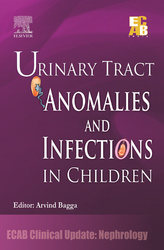「重要なお知らせ:日本語書籍をご購入いただき、eLibraryをご利用の皆さまへ」
エルゼビアは、より快適にサービスをご利用いただくため、システムの重要なアップデートを実施いたします。
現在、新サイト、eBooks+への移行が進められています。
新規ユーザー登録および書籍の登録はElsevier eLibraryでは停止しております。
12月15日以降に
こちらよりご利用・ご登録ください。
Book Description
Urinary tract disorders, be they anomalies or infections, are an important cause of acute and long-term morbidity in children. These conditions need prompt diagnosis and management, not only to relieve the acute morbidity, but also to prevent the long-term renal damage. This makes diagnostic and therapeutic issues concerning these conditions very important.
The most common urinary problem encountered in children is urinary tract infection (UTI), which is usually bacterial in origin. Urinalysis and culture play an important role in the diagnosis of this condition. The treatment consists of prompt and specific antibiotic therapy followed by genitourinary imaging in high risk patients to detect underlying urinary tract anomalies.
Vesicoureteric reflux (VUR) is characterized by retrograde flow of urine from the bladder to the kidneys, thereby predisposing it to UTI, and the two conditions together are believed to be associated with renal nephropathy. Patients with VUR have an increased risk of developing hypertension, toxemia of pregnancy, and significant renal damage, including end-stage renal disease subsequently in life. Based on the current literature, the author has enumerated various treatment options available for the different grades of VUR.
The urinary bladder is meant to function as a storage organ for urine that empties completely in an appropriate time and place. Any disorder that results involuntary passage of urine or inability to void to completion constitutes bladder dysfunction. Bladder dysfunction is increasingly recognized as a risk factor for UTI and VUR, and a cause for enuresis with daytime symptoms. Its diagnosis requires detailed clinical history and examination, non-invasive urodynamic tests, frequency volume charts, and abdominal ultrasonography to predict the type of bladder dysfunction. The author has emphasized on the importance of multidisciplinary approach in its management, comprising of medications, treatment of any underlying cause, scheduled voiding regimen, clean intermittent catheterization, positive reinforcement and where necessary, biofeedback strategies.
The book also contains a chapter on the management and long-term outcome of common kidney and urinary tract anomalies detected on antenatal screening such as unilateral or bilateral hydronephrosis,
multicystic dysplastic kidneys, and posterior urethral valves.


 (0 rating)
(0 rating) 




